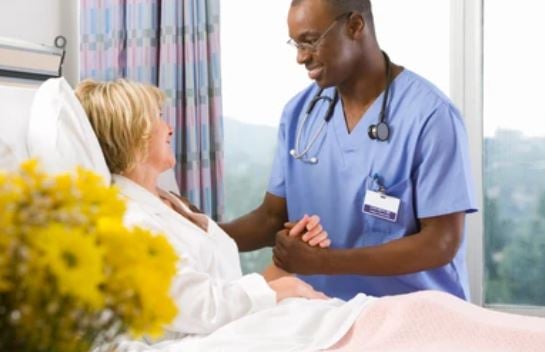Bedside Manner 101
By AccentCareThere was a time in health care where a clinician – or caregiver of any kind, really – could serve their patients, provide information or direction, prescribe medication, or perform a procedure and be… shall we say… less than warm and welcoming. They were there to provide a medical service, not necessarily a patient centered experience. Today, says Lindsey Haugen, Director of Quality at AccentCare Hospice, we know better so that our patients do better.

“Everyone likes to feel welcome, to feel heard, to have a positive experience,” said Haugen. “But this comes down to what is best for the patient. And we know that when those rapport building skills, those interactions with patients and family members, are better, then the outcomes for our patients are better. That’s the importance of bedside manner.”
Bedside manner is a concept every caregiver – and the public – has heard of before, even if they can’t define it exactly. Bedside manner can be viewed as the attitude and approach of a clinician with their patients or as the expected code of conduct in a facility.
“We see bedside manner as really the total approach to patient care, blending the professionalism required of clinicians and the unique personality of the patient,” said Haugen. “It’s about both the sharing and receiving of information, advice and understanding. Both patients and caregivers should be able to communicate comfortably and effectively.”
That might look very different for every patient and every caregiver – and that’s OK. A hospice physician and a labor-and-delivery nurse likely need to have very different conversations with their patients. In any case, no two caregivers or patients are alike either. But there are a couple of characteristics of good bedside manner that can be widely applied:
- Empathy – This is walking a mile in the other person’s shoes. “Empathy is the ability to not only understand someone’s state of mind or emotions, but to almost share it,” explained Haugen. “Using empathetic skills like active listening, you open a door to much more powerful, authentic, and trusting communication.”
- Body Language – Often overlooked or underestimated in the process, body language plays a critical role in power dynamics and open communication between a patient and their care team. “It’s important that providers are aware of their placement in a room and how they position themselves during a family meeting for optimal communication,” said Haugen. “Both the provider and the patient are communicating constantly through body language, especially during difficult conversations.”
When patients and their loved ones have an emotional connection with their caregivers, they are more likely to feel they are being treated like a whole person, that they are really understood, and that the caregivers can see their pain and understand their situation. That’s when patients express feeling more comfortable asking tough questions and sharing details they may have withheld otherwise.
“As caregivers, when we focus on our bedside manner, we are more likely to hear the patients’ real concerns and challenges,” said Haugen. “That leads to a whole host of benefits to them – and to tangible improvements in outcomes and the effectiveness of our care.”
Studies show that when patients feel that connection, they are more willing to trust recommendations and follow instructions of their medical provider and team. That means effective bedside manner can actually help predict quality of care, patient safety, and patient satisfaction.
“Patients view positive interactions as higher quality medical care,” said Haugen. “Altogether, good bedside manner positively impacts ‘hard health outcomes’ like obesity, diabetes, hypertension, asthma, pulmonary infections, and osteoarthritis pain.”
Not everyone has the same gifts when it comes to communication – and not everyone receives communication the same way. However, being empathetic and courteous helps gain a patient’s trust and boosts their confidence in their provider, which can equal greater levels of success after discharge. So, then the final step is training. Haugen encourages healthcare professionals to engage in the process of analyzing one’s body language, their facial expressions, and word choices when gathering patient history, delivering a new diagnosis, or sharing hard news – take all necessary and appropriate steps to make bedside manner as effective as it can be. It’s really a non-negotiable skill to embody in healthcare today.
“We’re clinicians, so we want to ensure we have research-based expertise in place to help us improve,” said Haugen. “Improving bedside manner is no different. It’s worth our time,” said Haugen, “and we owe it to our patients and to their loved ones.”
To learn more about Bedside Manner and much more, visit the on-demand continuing education library.